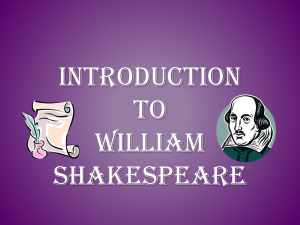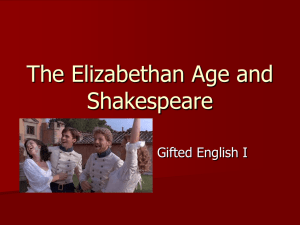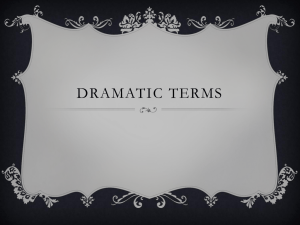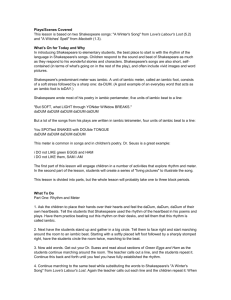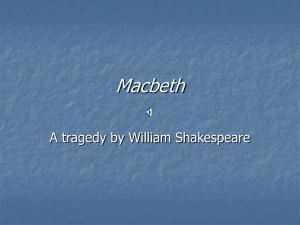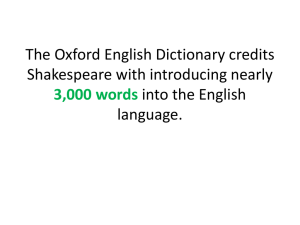Shakespeare in Love with Canavese`s Class
advertisement
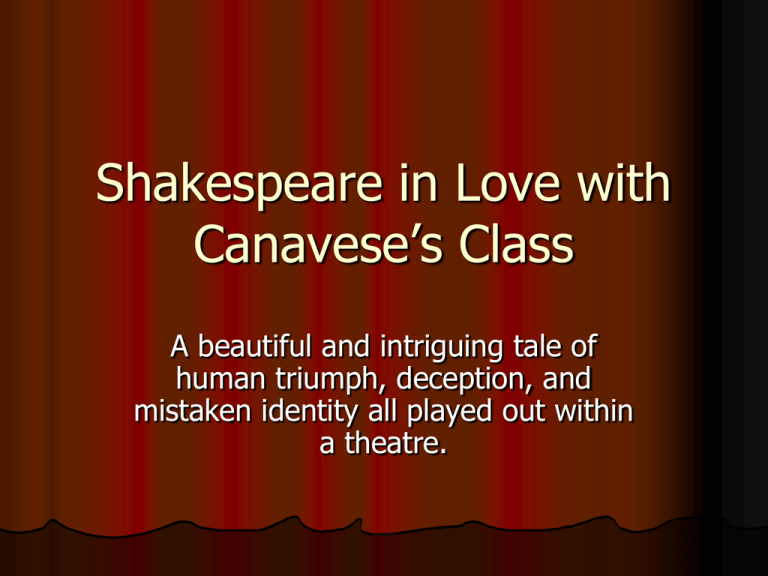
Shakespeare in Love with Canavese’s Class A beautiful and intriguing tale of human triumph, deception, and mistaken identity all played out within a theatre. The versin’ birth (and the beginning of a profitable tourist industry) b. ~ Apr. 23, 1564; d. Apr. 23, 1616 in Stratford – upon – Avon (river) Shakespeare’s birthplace Billy the Kid Father John (glover + town bailiff / councilman) longed to move up in social status – belong to the gentry Mother Mary (Arden)’s family was gentry, but she lost this distinction with marriage W.S. in grammar school: studied Latin, but English not offered as a subject; prob. studied some Greek; read classics in Latin, like works of Ovid. No math, science, history, geography On Tour Actors needed a license and patronage to tour + perform. Though revered as celebrities today, actors were considered low-class sorts by many in Shakespeare’s day. 1576, The Year that Was. Before 1576, all performances had been in inn (court)yards + guild halls. In 1576, James Burbage built the first theatre “in” London. It was in fact just outside London, for reasons explained on the next slide. Burbage’s building was called “The Theatre” (the word, from the Greek, means “seeing place”) Theatre was liked by the general public, but increasingly condemned by clergy + govt., who called it sinful, a drain on the time + $ of workers and a dangerous gathering of people. Those guys were referred to as real jerks. That Last Slide Continued London Council had, in 1574, put restrictions on acting companies, including no Sunday performances. (come on, what is this Communist China?) Burbage built his theatre just outside city limits The audiences included apprentices (who made up most of the groundlings) + women (who enjoyed the dirty jokes) Shakespeare worked w/ Burbage’s sons Cuthbert (business partner) and Richard (actor) for most of his career (1594-1610, at least) 1582, the Year that Was almost 1576 W.S. (age 18) married Anne Hathaway (age 26), who gave birth six months later (they may have had a “pre-contract” that made them an “official” couple). Lots of couples did this back in the day before they had their official wedding, so their child may not have been considered conceived out of wedlock. Still, the child may well have been the reason Shakespeare got married. (Think carefully before you shake your spears, boys.) A lot of tots fill slots; forget them not 1583: Daughter Susanna born. 1585: Twins Hamnet (boy) + Judith (girl) born Trouble in Paradise Soon after, W.S. left family in Stratford moved to London (Anne was probably Puritan, which would explain why she would not support his theatre career) However, this was not a very upstanding thing to do. If you have a family, you can’t just walk out on them, you just gotta sack up. But Shakespeare was a sweet writer, maybe even the sweetest writer ever, so people usually forgive him for leaving his family. Stratford to London 10 1585-1592: The Lost Years No historical records detail this period, but we assume he trained as an actor and… More importantly, made a decision from which he could never turn back, and which would ultimately change the course of history: he began to write plays... Also in 1592, some jerk was talking smack about our boy. W.S. attacked in print by university wit + former playwright Robert Greene, who wrote—no doubt jealous of this young man’s instant success—“There is an upstart crow, beautified with our feathers, that with his tyger’s heart wrapped in a player’s hyde, supposes he is as well able to bombast out a blank verse as the best of you: and being an absolute Johannes factotum, is in his own conceit the only Shake-scene in a country.” 1592-1594 1592-1594: Theatres closed by London Council due to the plague. With no reason to write for the stage, Shakespeare focused on writing poems. 1593: poem “Venus and Adonis” 1594: poem “The Rape of Lucrece” - Joined Lord Chamberlain’s Men (acting company), which was under the patronage of the Queen (the Master of the Revels approved plays for the Queen + eventually all of England) More stuff happens 1597: W.S. buys “New Place” in Stratford; secures family coat of arms; Lord Ch’s Men lose their lease 1599: W.S. becomes “partner” in Company, investing in the construction of the Globe Theatre 1603: Queen Elizabeth dies; King James I crowned; company becomes the King’s Men 1609: King’s Men acquire Blackfriars (indoor theatre) Retirement, fire, and death 1610: W.S. retires to Stratford; continues to write (in collaboration with John Fletcher) 1613: Globe burns during packed performance of W.S.’s Henry VIII April 23, 1616: the day the poetry died (yep, we think he died on his birthday) He bequeathed his "second-best bed" to his wife; often interpreted as a slight, but this would most likely have been the family bed, the “best bed” being for guests. Inscription on Shakespeare’s grave: Good friend for Jesus’ sake forbear To dig the dust enclosed here. Blest be the man that spares these stones, And curst be he that moves my bones. Life doesn’t go on (but the plays do) 1623: First folio published by 2 of Shakespeare’s former acting partners: John Heminges + Henry Condell. Previous Quartos were “bootleg” 1997: New Globe opened by Queen Elizabeth II Elizabethan Theatres Flowering of theatre. The Renaissance (rebirth) grew from England’s medieval theatre of mystery and morality plays with some stylistic infusion from educate men’s common reading of the Roman playwrights (Terence, Plautus, Seneca). City authorities would often ban theatrical productions… gatherings encouraged crime. Theatres: The Theatre and The Curtain in North London; The Rose, the Swan, and The Globe (1599) in South London. Christopher Marlow (1564-1593) – Tamburlane the Great, Faustus, Ben Jonson (1572-1637) – Volpone, The Fox Shakespeare (1564-1616) 17 Edward II Elizabethan Theatres 18 Wooden, circular structure, open to the sun The pit (groundlings) vs. the galleries Audience close to the actors Women not allowed on stage (teenage boys) No scenery, few props, but elaborate costumes Iambic Pentameter The poetic form used by Shakespeare is Iambic Pentameter Iambic Pentameter is a rhythmical pattern of syllables Iambic: rhythm goes from unstressed syllable to a stressed one. Rhythmic examples: “divine” “caress” “bizarre” Like a heartbeat: daDUM daDUM Each iamb is called a foot There are other rhythms. I.e., trochaic = DUMda Pentameter = the rhythm is repeated 5 times – each line is 10 syllables: daDUM daDUM daDUM daDUM daDUM 21 Iambic Pentameter Pentameter = the rhythm is repeated 5 times daDUM daDUM daDUM daDUM daDUM The Prince of Cumberland! That is a step On which I must fall down, or else o’er-leap, For in my way it lies. Stars, hide your fires! Let not light see my black and deep desires. 22 Shakespeare will sometimes end iambic pentameter on an unstressed syllable, so that the last foot sounds like this: daDUMda. To be, or not to be, that is the question. Is this a dagger which I see before me Blank Verse Blank Verse = unrhymed iambic pentameter Exceptions: Rhyming couplets often at the end of monologues/scenes, used for emphasis 23 Shakespeare’s Sonnets Sonnets = 14 lines of iambic pentameter Originally 24 created in Italy in the 1200’s Shakespearean Sonnet = 3 quatrains and a final couplet (ABAB CDCD EFEF GG) Elizabethan Age – Jacobean Age Shakespeare gains his notoriety during a time when theatre is flourishing – the Elizabethan Age. Named after Queen Elizabeth I, who reigns until 1603. King James I reigns during the rest of Shakespeare’s life. Shakespeare (arguably) writes Macbeth in 1606 to honor the King. 25 Elizabethan Age – Jacobean Age Queen Elizabeth (1558-1603) – Daughter of Henry VIII and Anne Boleyn. Protestant. The Virgin Queen. Takes throne from Mary I (aka Bloody Mary), a Catholic who executed Protestants in large numbers. Elizabeth I firmly establishes the Church of England (begun by her father); took the Church “the middle way” between Catholic origins and Protestant Reformation England emerges as the leading naval and commercial power of the Western world. Elizabeth I's England consolidates its position with the defeat of the Spanish Armada in 1588. Elizabeth names James VI of Scotland to be the heir to the throne. Takes the crown as James I, and rules from 1603-1625. The Jacobean Age. 26 16th century London center of culture and commerce. population grew 400% from 1500 to 1600, reaching nearly 200,000 people in the city proper and outlying region by the time Shakespeare arrived. Thriving merchant middle class Booming economy 27 The Four Humours A traditional theory of physiology in which the state of health - and by extension the state of mind, or character - depended upon a balance among the four elemental fluids: blood, yellow bile, phlegm, and black bile. These were closely allied with the four elements (air, fire, water, and earth). Their correspondence is described as follows… 28 The Humours SANGUINE: Blood Hot and moist; (Air) Amorous, happy, generous • PHLEGMATIC: Phlegm MELANCHOLIC: Black Bile Cold and dry ; (Earth) • Gluttonous, lazy, sentimental 29 – Cold and moist; (Water ) – Dull, pale, cowardly CHOLERIC: Yellow Bile – Hot and dry; (Fire) – Violent, vengeful The Humours 30 The "humours" gave off vapors which ascended to the brain; an individual's personal characteristics (physical, mental, moral) were explained by his or her "temperament," or the state of that person's "humours." The perfect temperament resulted when no one of these humours dominated. By 1600 it was common to use "humour" as a means of classifying characters; knowledge of the humours is not only important to understanding later medieval work, but essential to interpreting Elizabethan drama. Shakespeare’s Life http://shakespeare.palomar.edu/quiz/bioq uiz.htm 31
